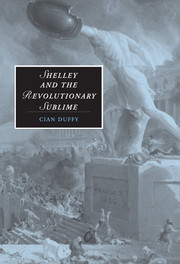Book contents
- Frontmatter
- Contents
- Acknowledgements
- Note on texts
- List of abbreviations
- Introduction: Approaching the ‘Shelleyan sublime’
- 1 From religion to revolution, 1810–1813
- 2 Cultivating the imagination, 1813–1815
- 3 Mont Blanc and the Alps, 1816
- 4 Writing the revolution: Laon and Cythna (1817)
- 5 ‘Choose reform or civil war’, 1818–1819
- Conclusion: ‘Good and the means of good’, 1822
- Notes
- Bibliography
- Index
- CAMBRIDGE STUDIES IN ROMANTICISM
Introduction: Approaching the ‘Shelleyan sublime’
Published online by Cambridge University Press: 15 December 2009
- Frontmatter
- Contents
- Acknowledgements
- Note on texts
- List of abbreviations
- Introduction: Approaching the ‘Shelleyan sublime’
- 1 From religion to revolution, 1810–1813
- 2 Cultivating the imagination, 1813–1815
- 3 Mont Blanc and the Alps, 1816
- 4 Writing the revolution: Laon and Cythna (1817)
- 5 ‘Choose reform or civil war’, 1818–1819
- Conclusion: ‘Good and the means of good’, 1822
- Notes
- Bibliography
- Index
- CAMBRIDGE STUDIES IN ROMANTICISM
Summary
It has become something of a commonplace to begin a study of Percy Shelley by noting the extraordinary fluctuation in his posthumous standing, personal no less than literary. In the years since his death, critics and commentators have given us a range of different Shelleys. It is fair to say that many of these portraits are radically misconceived, and often patronisingly reductive. From the nineteenth century, we inherit the Satanic Shelley, Shelley the ‘lunatic angel’, Shelley the ‘beautiful and ineffectual angel’, Shelley ‘the eternal child’. And while such ad hominem accounts were largely abandoned in the early twentieth century, critical appraisal of Shelley's work frequently remained condemnatory and dismissive. The New Critics and their followers gave us the vague and incomprehensible Shelley, the philosophically confused Shelley, the politically naive Shelley. More recent criticism has effectively refuted these charges, and Shelley's epistemological and political maturity is no longer in any serious doubt. But one important aspect of his work has yet to benefit from this critical renaissance. Shelley's engagement with the ‘discourse on the sublime’ remains relatively unexplored and largely misunderstood, and this despite ‘all those glaciers and winds and volcanoes’ that Paul Foot and others have noted in his ‘great revolutionary poetry’. This book explores the relationship between the sublime and the revolutionary in Shelley's work.
Critical investigation of Shelley's interest in the natural sublime has laboured under persistent misconceptions about the development of his thought – and, indeed, about the nature of the ‘romantic sublime’ per se.
- Type
- Chapter
- Information
- Shelley and the Revolutionary Sublime , pp. 1 - 12Publisher: Cambridge University PressPrint publication year: 2005

